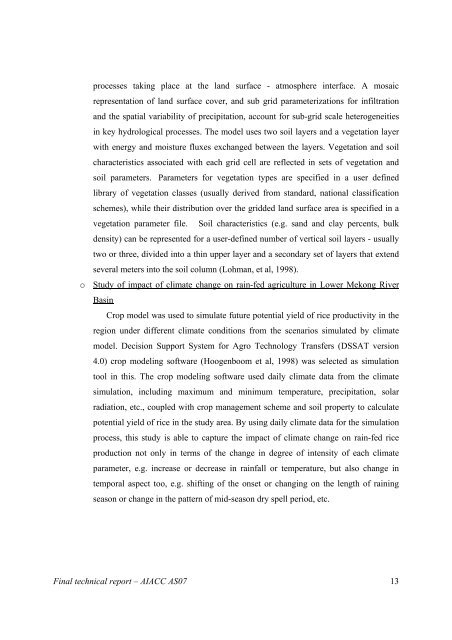Final Technical Report - weADAPT
Final Technical Report - weADAPT
Final Technical Report - weADAPT
- No tags were found...
You also want an ePaper? Increase the reach of your titles
YUMPU automatically turns print PDFs into web optimized ePapers that Google loves.
processes taking place at the land surface - atmosphere interface. A mosaic<br />
representation of land surface cover, and sub grid parameterizations for infiltration<br />
and the spatial variability of precipitation, account for sub-grid scale heterogeneities<br />
in key hydrological processes. The model uses two soil layers and a vegetation layer<br />
with energy and moisture fluxes exchanged between the layers. Vegetation and soil<br />
characteristics associated with each grid cell are reflected in sets of vegetation and<br />
soil parameters. Parameters for vegetation types are specified in a user defined<br />
library of vegetation classes (usually derived from standard, national classification<br />
schemes), while their distribution over the gridded land surface area is specified in a<br />
vegetation parameter file. Soil characteristics (e.g. sand and clay percents, bulk<br />
density) can be represented for a user-defined number of vertical soil layers - usually<br />
two or three, divided into a thin upper layer and a secondary set of layers that extend<br />
several meters into the soil column (Lohman, et al, 1998).<br />
o Study of impact of climate change on rain-fed agriculture in Lower Mekong River<br />
Basin<br />
Crop model was used to simulate future potential yield of rice productivity in the<br />
region under different climate conditions from the scenarios simulated by climate<br />
model. Decision Support System for Agro Technology Transfers (DSSAT version<br />
4.0) crop modeling software (Hoogenboom et al, 1998) was selected as simulation<br />
tool in this. The crop modeling software used daily climate data from the climate<br />
simulation, including maximum and minimum temperature, precipitation, solar<br />
radiation, etc., coupled with crop management scheme and soil property to calculate<br />
potential yield of rice in the study area. By using daily climate data for the simulation<br />
process, this study is able to capture the impact of climate change on rain-fed rice<br />
production not only in terms of the change in degree of intensity of each climate<br />
parameter, e.g. increase or decrease in rainfall or temperature, but also change in<br />
temporal aspect too, e.g. shifting of the onset or changing on the length of raining<br />
season or change in the pattern of mid-season dry spell period, etc.<br />
<strong>Final</strong> technical report – AIACC AS07 13
















